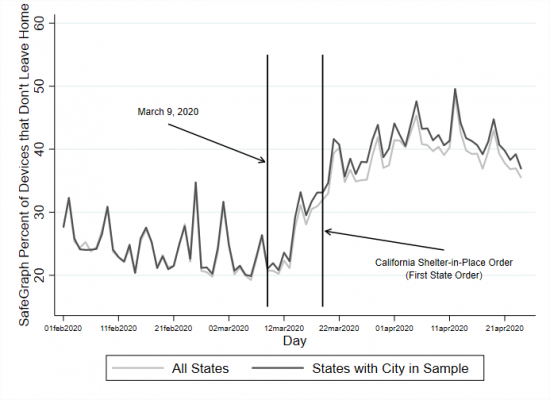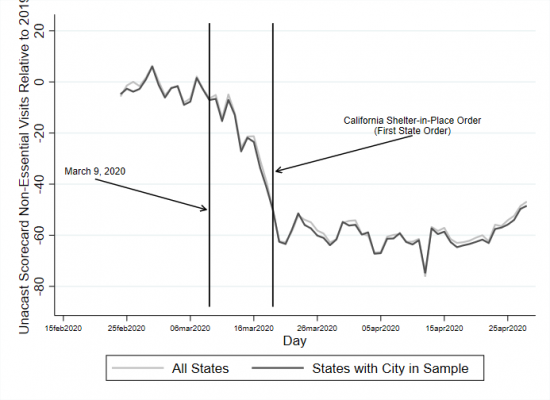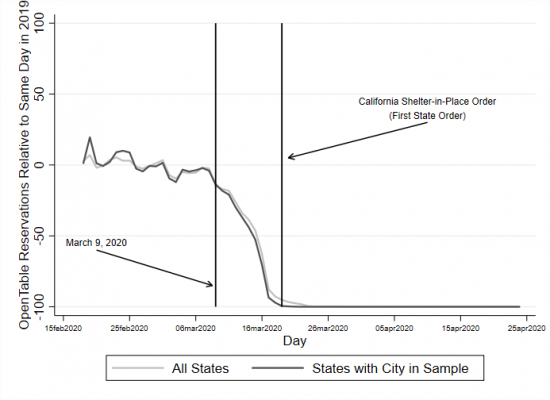
 During the COVID-19 pandemic, millions of people across the world have been sheltering at home for several months, a shift which is sadly likely to mean a rise in domestic violence cases. After adjusting domestic violence call data for seasonal trends, Emily Leslie and Riley Wilson find that domestic violence increases by about ten percent compared to the same period in 2019 – an equivalent to nearly 1,400 additional cases across the US each day.
During the COVID-19 pandemic, millions of people across the world have been sheltering at home for several months, a shift which is sadly likely to mean a rise in domestic violence cases. After adjusting domestic violence call data for seasonal trends, Emily Leslie and Riley Wilson find that domestic violence increases by about ten percent compared to the same period in 2019 – an equivalent to nearly 1,400 additional cases across the US each day.
The worldwide COVID-19 pandemic has pushed people to spend more time at home, amidst increased uncertainty and soaring unemployment rates. The best available evidence tells us that these conditions have the potential to increase domestic violence. The results could be tragic. The impact of domestic violence reaches beyond the direct emotional and physical harm to victims to depress wages and increase dependence on public assistance, and to damage infant health outcomes.
We find that the pandemic caused domestic violence calls for service to police to increase about 10 percent in the United States. The increase came across a broad range of demographic and socioeconomic groups and includes households without a recent history of domestic violence calls.
Simply observing a rise in domestic violence incidents does not mean the pandemic lockdowns have increased domestic violence. Many types of crime experience seasonal trends (increasing when it gets hot) and there could be changes in reporting behavior. The role of government policy in the matter is also unclear, as many households and businesses began social distancing and home-isolation practices before any government mandates were issued. By using police calls for service data from 15 large US cities, we track how domestic violence related calls evolve over time and identify the total impact of the COVID-19 pandemic on domestic violence calls.
It would seem natural to use government enacted stay-at-home orders to indicate when the pandemic started to affect the lives of people in our sample areas. However, mobile device tracking data from SafeGraph and Unacast, as well as OpenTable restaurant seated diner data, indicate behavior began to change around March 9, 10 days before the first stay-at-home order went into effect (see Figure 1). If we compare the daily number of domestic violence calls in 2020 within city, we find that domestic violence calls are nearly 15 percent higher after March 9th. However, as you can see in Figure 2, there is an uptick in calls in March of 2019 as well as 2020, suggesting any estimation that overlooks seasonal trends will overstate the impact of the pandemic.
Figure 1 – Trends in Social Distancing Practices



Source: Authors’ own calculations using cell-device tracking data from SafeGraph, cell-device tracking data from Unacast, and seated diner data from OpenTable.
Figure 2 – Trends in Domestic Violence

Notes: The red line indicates the final week before March 9th, when social distancing practices began. The blue line indicates March 19th, the date of the first stay-at-home mandate issued by California. The inverse hyperbolic sine is a transformation, similar to a log transformation, allowing us to interpret changes as percent changes.
Source: Author’s own calculations using Police Call for Service data and OpenTable seated diner data.
When we compare calls between 2019 and 2020, before and after March 9 (controlling for various state and seasonal trends), we estimate that domestic violence was about 10.2 percent higher during the last few weeks of March in 2020 compared with the same weeks in 2019. Failing to account for seasonal trends would cause us to overestimate the effect by 46 percent. Our estimates suggest that the pandemic has led to about 3.3 more domestic violence calls per city every day. If the entire United States experienced a similar increase, the result would be about 1,350 more domestic violence calls each day. The immediate medical and productivity costs, and the long-run negative impacts on earnings could cost society tens of millions of dollars each day.
The increase in domestic violence calls is not just down to an increase in reporting
Domestic violence calls are not a perfect measure of domestic violence incidents. If victims find it more difficult to report during the pandemic because their abusers spend more time at home, then our analysis would understate the increase in domestic violence. On the other hand, third party reporting could increase due to more neighbors being at home. To test for this, we compare effects in areas with lots of multi-unit housing (where neighbors are likely to hear more through shared walls) to places with less multi-unit housing. The results for the two subgroups are nearly identical, suggesting that our findings are not just picking up an increase in reporting by neighbors.

Photo by Sincerely Media on Unsplash
We would like to know which of the channels through which the pandemic could affect domestic violence is most important. Is it more time at home? A worse economy? Higher levels of stress generally? Unfortunately, it’s not possible to definitively tease these apart. Pandemic-induced job loss is pervasive everywhere, so it’s difficult to find places with low levels of job loss to compare with high-job-loss areas. We don’t see consistently larger effects in communities that may be more financially vulnerable (e.g. areas with more people of color or low-income households). Effects seem to be larger on weekdays compared with weekends, which is consistent with increased time at home together, especially during hours when adults may be trying to work from home and/or help children with schoolwork, playing a role.
More new households reporting domestic violence
Finally, we investigate whether the increase is driven by households with a history of domestic violence. We don’t have exact address information in our data, but we do know what city block the call came from for some of the cities in our sample. We divide the city blocks into groups based on whether they had a domestic violence call during the previous year and compare effects in the two groups. Our estimates suggest larger effects on city blocks without a previous domestic violence call, meaning new households contribute to the overall increase that we observe.
Given that the increase in domestic violence calls started before stay-at-home orders, state-level social distancing policy may not be relevant to influencing domestic violence. On the other hand, when we look at cities whose calls for service data extends through April, when our data suggests social distancing compliance began to wane, we find that the increase in domestic violence calls during March was largely reversed. It’s also possible that the prospect of financial relief that came with the passage of the first congressional stimulus bill on March 27 helped reduce household stress and with it, domestic violence. We need more evidence to know for sure what interventions can help make homes safe for everyone during the current crisis, but policies that help households stay afloat financially may be a promising place to start.
- This article is based on the SSRN paper, “Sheltering in Place and Domestic Violence: Evidence from Calls for Service during COVID-19“.
Please read our comments policy before commenting.
Note: This article gives the views of the authors, and not the position of USAPP – American Politics and Policy, nor the London School of Economics.
Shortened URL for this post: https://bit.ly/2UvDIJp
About the authors
 Emily Leslie – Brigham Young University
Emily Leslie – Brigham Young University
Emily Leslie is an Assistant Professor of Economics at Brigham Young University. She studies crime and the criminal justice system. Twitter: @emilycleslie
 Riley Wilson – Brigham Young University
Riley Wilson – Brigham Young University
Riley Wilson is an Assistant Professor of Economics at Brigham Young University. He studies labor markets and the impacts of government social programs. His recent work explores people’s decisions to move to economic opportunity and behavioral responses to programs like the Earned Income Tax Credit. Twitter: @1rileywilso






